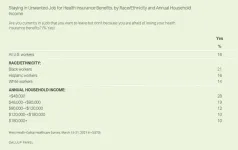(Press-News.org) PULLMAN, Wash. -- With state legislatures nationwide preparing for the once-a-decade redrawing of voting districts, a research team has developed a better computational method to help identify improper gerrymandering designed to favor specific candidates or political parties.
In an article in the Harvard Data Science Review, the researchers describe the improved mathematical methodology of an open source tool called GerryChain. The tool can help observers detect gerrymandering in a voting district plan by creating a pool, or ensemble, of alternate maps that also meet legal voting criteria. This map ensemble can show if the proposed plan is an extreme outlier--one that is very unusual from the norm of plans generated without bias, and therefore, likely to be drawn with partisan goals in mind.
An earlier version of GerryChain was used to analyze maps proposed to remedy the Virginia House of Delegates districts that a federal court ruled in 2018 were unconstitutional racial gerrymanders. The updated tool will likely play a role in the upcoming redistricting using new census data.
"We wanted to build an open-source software tool and make that available to people interested in reform, especially in states where there are skewed baselines," said Daryl DeFord, assistant mathematics professor at Washington State University and a co-lead author on the paper. "It can be an impactful way for people to get involved in this process, particularly going into this year's redistricting cycle where there are going to be a lot of opportunities for pointing out less than optimal behavior."
The GerryChain tool, first created by a team led by DeFord as a part of the 2018 Voting Rights Data Institute, has already been downloaded 20,000 times. The new paper, authored by Deford along with Moon Duchin of Tufts University and Justin Solomon of the Massachusetts Institute of Technology, focuses on how the mathematical and computational models implemented in GerryChain can be used to put proposed voting districting plans into context by creating large samples of alternative valid plans for comparison. These alternate plans are often used when a voting plan is challenged in court as being unfair as well as to analyze potential impacts of redistricting reform.
For instance, the enacted 2010 House of Delegates plan in Virginia had 12 voting districts with a Black voting age population at or above 55%. By comparing that plan against an ensemble of alternate plans that all fit the legal criteria, advocates showed that map was an extreme outlier of what was possible. In other words, it was likely drawn intentionally to "pack" some districts with a Black voter population to "crack" other districts, breaking the influence of those voters.
One of the biggest challenges to creating voting maps are the sheer number of possibilities, DeFord said. Many states like Virginia have hundreds of thousands of census blocks. They also have many rules and goals for structuring voting districts: such as keeping them geographically contiguous and compact with units like counties and cities intact. Many states also want to protect "communities of interest" an often undefined term, but the federal Voting Rights Act explicitly aims to protect minority voters, since historically, gerrymanders have sought to weaken the effect of their vote. In addition, multiple states require that voting maps be drawn with an attempt at political neutrality.
Even with all these rules, voting maps can still be drawn in a myriad of different ways.
"There are more feasible plans in a lot of states than there are molecules in the universe," Deford said. "That's why you want this kind of mathematical tool."
Since the advent of computers, models have provided the ability to make an array of maps. Before the current version of Gerrychain, many models used a data method called a "Flip walk" to create alternatives, which involves changing just one assignment at time, such as a precinct or census block. Every change has a ripple effect on other districts, resulting in a different map.
The tool developed by DeFord and his colleagues uses a method called a spanning tree recombination or "ReCom" for short. To create an alternative voting map, the method involves taking two districts, merging them together before splitting them apart again in a different way. This creates a greater change with multiple voting blocks changing at a time.
The computational tool can create many alternative voting plans within a matter of hours or days, and it is freely available for use by voting reform groups or anyone who has knowledge of Python, the data software behind it.
The authors emphasize, however, that computers alone shouldn't create the voting plan that is ultimately adopted for use. Rather the ensemble method provides a tool for analyzing baselines and evaluating potential alternatives.
"This is not some sort of magic black box where you push the button, and you get a collection of perfect plans," said Deford. "It really requires serious engagement with social scientists and legal scholars. Because the rules are written and implemented by people, this is a fundamentally human process."
INFORMATION:
The identity of the skeletal remains of a member of the 1845 Franklin expedition has been confirmed using DNA and genealogical analyses by a team of researchers from the University of Waterloo, Lakehead University, and Trent University. This is the first member of the ill-fated expedition to be positively identified through DNA.
DNA extracted from tooth and bone samples recovered in 2013 were confirmed to be the remains of Warrant Officer John Gregory, engineer aboard HMS Erebus. The results matched a DNA sample obtained from a direct descendant of Gregory.
The remains of the officer were found on King William Island, Nunavut. "We now know that John Gregory was one of three expedition personnel who ...
A team of engineers recommends expanding fast-charging stations for electric vehicles as campuses and businesses start planning for a post-pandemic world.
The recommendation is based on a study of charging patterns for electric vehicles on the University of California San Diego campus from early January to late May of 2020, after the university moved most of its operations online. Researchers say the findings can be applied to a broader range of settings.
"Workplace charging is a critical enabler of carbon-free transportation as the electrons consumed primarily come from solar power plants, as opposed to at-home charging, which occurs at night and relies more on fossil ...
WASHINGTON, DC - MAY 6, 2021 - One out of every six adult workers (16%) in the United States are staying in jobs they might otherwise leave out of fear of losing their employer-sponsored health insurance, according to a new West Health-Gallup survey of more than 3,800 U.S. adults.
The survey finds the fear is even more pronounced among Black workers, who are 50% more likely to remain in an unwanted job than their White and Hispanic counterparts (21% to 14% and 16%, respectively).
But the most likely to stay in a job they would rather leave are those workers in households earning less than $48,000 a year -- roughly 3 in 10 (28%) say they will not leave and risk losing their health benefits. Workers in lower income households are nearly ...
Sophia Antipolis, 6 May 2021: One in four heart attack patients have atypical symptoms such as breathing difficulties, extreme exhaustion, and abdominal pain, according to a study published today in European Heart Journal - Acute Cardiovascular Care, a journal of the European Society of Cardiology (ESC).1 Patients with atypical symptoms were less likely to receive emergency help and more likely to die within 30 days compared to those with chest pain.
"We found that atypical symptoms were most common among older people, especially women, who called a non-emergency helpline for assistance," said study author Ms. Amalie Lykkemark Møller, PhD student, Nordsjællands Hospital, ...
A large study from Denmark and Norway published by The BMJ today sheds more light on the risk of rare blood clots in adults receiving their first dose of the Oxford-AstraZeneca covid-19 vaccine.
The findings show slightly increased rates of vein blood clots including clots in the veins of the brain, compared with expected rates in the general population. However, the researchers stress that the risk of such adverse events is considered low.
Cases of rare blood clots in people who have recently received their first dose of the Oxford-AstraZeneca covid-19 vaccine have been reported. Whether these cases represent excess events above expected ...
The new Danish-Norwegian study is the first study to document possible adverse events in relation to the COVID-19 vaccine Vaxzevria? from AstraZeneca, in which all vaccine recipients have been followed systematically, as opposed to previous studies, which have relied primarily on reported adverse reactions.
The new study was a cooperation between Danish and Norwegian research institutions.
- In this study, we were able to identify all hospital contacts among vaccinated persons by utilising the unique Danish and Norwegian health registers. This ensures that we get a comprehensive of the rate of adverse reactions. ...
Some clinicians are concerned that post-traumatic stress disorder (PTSD) diagnosis has risen throughout Western society since the late 1980s. Is this correct? And if so, has the true incidence of PTSD really spiralled out of control, or has it simply become overdiagnosed?
Experts debate the issue in The BMJ this week.
PTSD is a serious and uncommon condition resulting from severe trauma, but it has unhelpfully become an umbrella term incorporating other disorders and normal reactions to stress, argue John Tully at the University of Nottingham and Dinesh Bhugra at King's College London's Institute for Psychiatry, Psychology & Neuroscience (IoPPN).
Estimates of lifetime population prevalence are now about 7% in the US (26 million cases) and 5% in other high income countries. ...
Admission to an intensive care unit (ICU) is associated with a small increased risk of future suicide or self-harm after discharge compared with non-ICU hospital admissions, finds a study published in The BMJ today.
The findings are particularly relevant during the covid-19 pandemic, as the number of ICU admissions around the world reach all-time highs.
The findings show that survivors of critical illness who later died by suicide or had self-harm events tended to be younger with a history of psychiatric illness, and had received invasive life support.
The researchers stress that the overall risk is still very low, but say knowledge of these factors "might allow for earlier intervention to potentially reduce this important public health problem."
Survival after ...
Israel is the first country to report national data on the Pfizer-BioNTech vaccine, with observational analysis showing that two doses provide more than 95% protection against COVID-19 infection, hospitalisation, and death, including among the elderly, at a time when the B.1.1.7 variant was the dominant strain.
A single dose of the vaccine was associated with 58% protection against infection, 76% against hospitalisation, and 77% against death, emphasising the importance of fully vaccinating adults.
Challenges to controlling the pandemic remain, including uncertainty about ...
R21/Matrix-M becomes the second malaria vaccine candidate ever to start a phase III licensure trial
This builds on the recent finding of high level efficacy of this vaccine in a phase IIb trial in children in Burkina Faso, published today in The Lancet
The first phase III trial doses were administered by the team at the Malaria Research and Training Centre, Bamako, Mali, one of five trial sites across West and East Africa
The malaria vaccine was designed at the Jenner Institute, University of Oxford, who have partnered with the Serum Institute of India for commercial development
The annual death toll from ...



